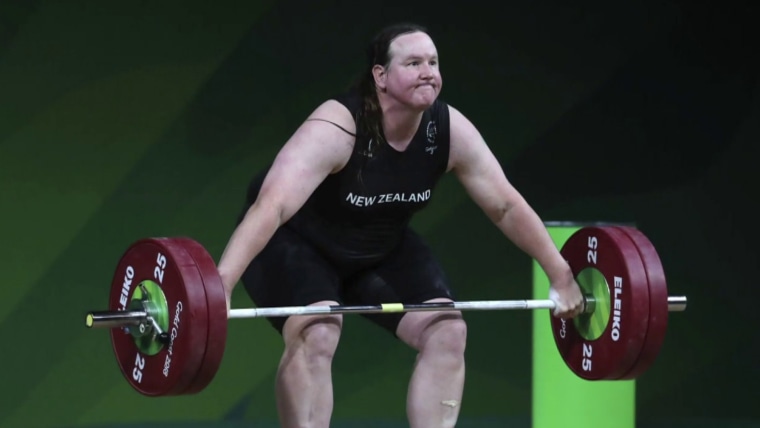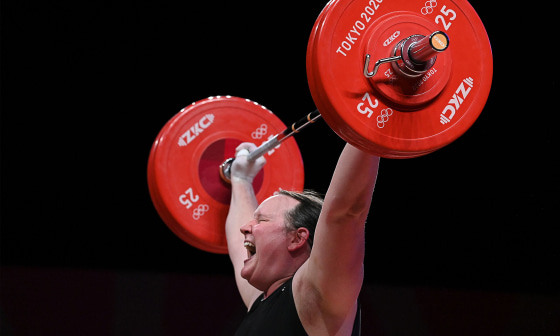By all appearances, Olympic weightlifter Laurel Hubbard never sought to be a transgender activist. While the world launched into a passionate debate over her body, gender and potential athletic ability, Hubbard herself didn’t speak much with the press in the runup to the Games. Her job is not to be a trans trailblazer or an outspoken advocate for transgender rights; her job is to lift things up and put them down.
The IOC has said it’s going to review its trans inclusion policy after this year’s games.
That didn’t stop the breathless and consternated coverage in the right-wing and the British media over Hubbard having an “unfair biological advantage” due to her transgender status. Articles appeared with bold headlines predicting the alleged end of women’s sports if Hubbard were allowed to compete in this year’s Games. After all, the anti-trans argument went, people assigned male at birth are naturally superior at sports and so obviously Hubbard would win.
Only, she didn’t. Not even close.

Early Monday, Hubbard crashed out from the Olympic women’s weightlifting competition after failing to complete any of her three attempts in the snatch. She missed her first attempt at 120 kilograms, then appeared to lift her second attempt at 125 kilograms over her head, though officials ruled it a “no lift.” On her third and final attempt at 125 kilograms, Hubbard failed to stand up with the weight. She was the only competitor in the field not to complete a lift.
“Thank you so very much for your interest in my humble sporting performance tonight,” Hubbard said to the media afterward. “I know from a sporting perspective, I did not live up to the standards I put upon myself... I know my participation in these Games has not been entirely without controversy.”
It would appear that women’s sports are still intact, despite years of transphobic and gender critical hand-wringing over trans participation. And the status of women’s sports is hardly determined by one trans competitor competing somewhere in the world in one sport anyway.
But Hubbard still made history by becoming the first openly trans woman to compete in a women’s sport in the Olympics since the International Olympic Committee first allowed trans women to compete as women with bottom surgery in 2004. The IOC later relaxed the rules in 2015, allowing trans women to compete without surgery but under a heavily regulated testosterone limit.
Many trans women tried and failed to qualify for this year’s games.
Many trans women tried and failed to qualify for this year’s Games. BMX biker Chelsea Wolfe was an alternate for the U.S. team but didn’t compete. Elsewhere in the U.S., marathoner Megan Youngen finished 306th in the U.S. Olympic trials.
Hubbard’s performance in the Games should undermine many of the arguments against trans inclusion in women’s sports, but it won’t. Ranked number 16 in the world coming in, she wasn’t favored to win the event, but she had an outside chance at a medal. Those unfamiliar with women’s weightlifting assumed that Hubbard would breeze through the competition on the back of her “male biology.” Nothing of the sort occurred.

Naysayers have been decrying the supposed “end of women’s sports” since Renee Richards successfully sued to be able to play on the professional women’s tennis tour in 1976. Now, 50 years later, there’s yet to be a dominant trans woman athlete in any sport, and trans women remain medalless in the Olympics.
The key to realizing why is understanding the science of testosterone. Most basically, testosterone generally helps bodies rebuild muscle faster after workouts and training than estrogen, allowing an athlete with a testosterone-dominant body to work out harder and more often than someone who’s body runs primarily on estrogen.
Olympic rules require transgender women to lower their testosterone level for at least a year straight before being allowed to compete in women’s sports. This typically, although not always, happens with a normally-prescribed regimen of hormone replacement therapy (HRT).
The IOC has said it’s going to review its trans inclusion policy after this year’s Games. It’s expected to lower the testosterone limit allowable for participation in the Games. Such a change is unlikely to have a significant impact on whether Hubbard or other trans women are still able to compete in the Olympics.
That won’t stop the haters from renewing this media circus the next time a trans woman competes in the Olympics.
If there’s one takeaway from Hubbard’s disappointing finish, it’s that trans women are not a threat to women’s sports. We could have spent all those headlines and Twitter threads on the incredible Li Wenwen, who set an Olympic record in the event early Monday.
That may be the most disappointing thing about the discourse over trans athletes: So much time and effort is spent demonizing trans women and calling for their banishment by people who allegedly want to “save women’s sports” that all the other amazing women are just completely ignored.

